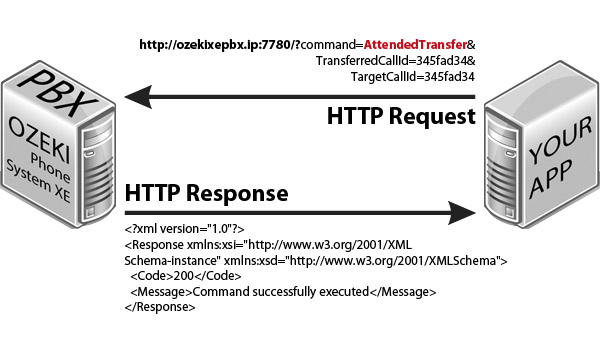AttendedTransfer
The AttendedTransfer command transfers the call during the conversation, before transferring, the transferor must call the target party, while the transfered party changes from InCall state to Hold state. (Find out what kind of CallStates a call can have.) When the command is initiated the transferor leaves both calls and the transfered party and target party will be connected. You can see how to use this command in a HTTP request and what HTTP response you will get from the phone system (Figure 1).

Request parameters
| Parameter name | Value | Description | Mandatory |
| command | string value, AttendedTransfer | Specifies the type of the HTTP API command. | Yes |
| TransferredCallId | string value, e.g. 270Okv |
The call ID of the call you chose the participant to be transfered from. | Yes |
| TargetCallId | string value, e.g. HL1bE |
The call ID of the call you want the participant to be transfered to. | Yes |
| These parameters are only required if office user authentication is set in the HTTP API: | |||
| Parameter name | Value | Description | |
| Username | string value, e.g. user1000 |
This is the username of an Ozeki Phone System office user. | |
| Password | string value, e.g. mypassword12 |
This is the password belonging to the username. | |
Response parameters
| Parameter name | Value | Description |
| Code | int value (200, 300, 301, 302, 303, 601) |
Returns the status code of the response. For more infromation go to the status code reference page |
| Message | string value, e.g. Command successfully executed |
Returns the description of the response code. For more infromation go to the status code reference page |
How to use it?
Step 1: The person who would like to be transfered calls you or you call him/her. You put him/her on hold and call the target party who he/she will probably be transferred to.
Step 2: Ask the target party if he/she is going to accept the transfer. If yes, go to step 3.
Step 3: Use ListActiveCalls command to find the call ID of the call you want to attendedtransfer and the call ID of the call the target party is in. You can find the CallIds in the response, between the <CallId></CallId> nodes.
Step 4: Initiate an AttendedTransfer using a HTTP request as seen in the picture above. Paste the call IDs you found in Step 3 in the TransferredCallId and TargetCallId parameters of the request.
